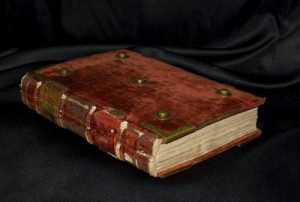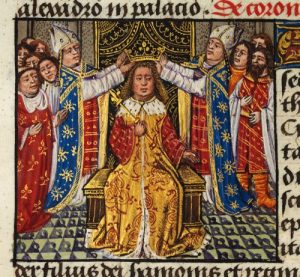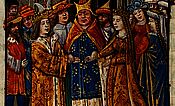The Peniarth 481D is a medieval manuscript archived at the National Library of Wales. It is among the most elaborately decorated manuscripts in the library, and it survived in its original binding (“The Battles of Alexander the Great.”). It is rare for a manuscript to retain its original binding due to decay, insects and owners selling off individual pages. This manuscript was bound in England in the late 15th century in wooden boards. The manuscript was bound to wooden boards because it was written on parchment or animal membrane. Parchment is affected by the environment and changes in humidity so, “books with parchment pages were bound with strong wooden boards and clamped tightly shut by metal (often brass) clasps or leather straps; this acted to keep the pages pressed flat despite humidity changes” (“Parchment or Vellum”). The text was written in the center of the parchment leaving a significantly amount of white space. The scribes could have decided to do this in order to preserve the text if it ever endured any damage due to humidity.

NLW MS Peniarth 481D
The manuscript contains two parts. The first part of the manuscript was written by an English scribe and illustrated by a Flemish artist. The texts it contains are Disticha Catonis, a popular Latin textbook, and ‘The History of Alexander’s Battles. The second part of the manuscript was written in Cologne and contains John of Hildesheim’s ‘History of the Three Kings’, the biblical story of Christmas (“The Battles of Alexander the Great.”). This manuscript could have been written for the educated or nobility because part of the manuscript was written in Latin. During this time period those who were considered ‘literate’ are the population that could read and write in Latin. So this manuscript could have been used for a scholarly textbook. Portions of this manuscripts recount history and biblical stories which lead to nationalistic ideals. In the Medieval Ages the fall of the Roman Empire helped shaped society so, by glorifying Alexander the Great and including biblical stories in the same manuscript could have been a ploy to unify and strengthen the power within the Church.

The coronation of Alexander (f. 60v.)
Manuscripts were used as a form of propaganda from the Church to unify the general population but since this was written in Latin the Church probably wanted to control kings or individuals that had power in communities. By targeting the educated or noble the Church can have those in the communities that had actual power influence the communities for them. Since most scribes were monks, or members of the Church, it was difficult to break away from the Church’s influences.
As said earlier, this manuscript is among the most elaborately decorated manuscripts in the library which could mean it was meant for individuals with wealth or decadence. The illustrations included ink of red, blue and gold. The inclusion of a variety of colors is why this manuscript is an example of an illuminated manuscript. An illuminated manuscript is a “handwritten book that has been decorated with gold or silver, brilliant colours, or elaborate designs or miniature pictures” (The Editors of Encyclopædia Britannica). The usage of such colorfully imagery was essential indicating important text. Also these decorations could help guide people through it. Since many people, even those who owned manuscripts, could not read the pictures were important in order to spread the ideology or information the manuscripts contained (“Fact #1: What is an Illuminated Manuscript”). Since the early history of this manuscript is a mystery, the original owners could have been those of the ‘illiterate’ population because the scribe chose to illuminate the text with the Flemish artist. Imagery was important during this time period and even though the texts include history and textbooks, a picture is worth a thousand words.

The marriage of Alexander and Darius’ daughter (f. 61v.)
The first known owner of this manuscript was Sir. John Cutts of Childerly, Cambridgeshire and Thomas Gawdy of Sniterton, Norfolk in the 17th century (“The Battles of Alexander the Great.”). An entire two centuries have past since the creation of the manuscript and the fact that it is still in tact is outstanding. The only recorded history surrounding the manuscript depicts the owners to all have noble blood which makes one wonder, what types of people possessed the manuscript prior to the 17th century? There could be no recorded history about the location of the manuscript due to the English Reformation in the 16th century. Owning a manuscript containing biblical stories that were written before the English Reformation was probably looked down upon. For instance, “The Tate estimates we lost 90% of our religious art” (de Lisle).
The only reasons this manuscript was able to survive six centuries of destruction was due to its binding and whomever took care of it with their due diligence.
Works Cited
“The Battles of Alexander the Great.” Llyfrgell Genedlaethol Cymru – The National Library of Wales: The Battles of Alexander the Great. N.p., n.d. Web.
De Lisle, Leanda. “A Sad Reminder of the Art Lost in the Years after the Reformation.” CatholicHerald.co.uk. N.p., 08 Oct. 2013. Web.
The Editors of Encyclopædia Britannica. “Illuminated Manuscript.” Encyclopædia Britannica. Encyclopædia Britannica, Inc., 27 Nov. 2014. Web.
“FACT #1: What Is an Illuminated Manuscript?” Minneapolis Institute of Art. N.p., n.d. Web.
“Parchment or Vellum.” Cortume Runge. N.p., n.d. Web.